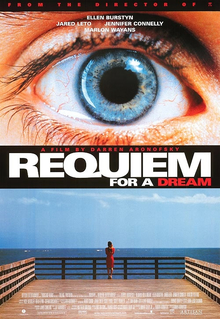If there’s anything the “war on drugs” has taught me, it’s that “drugs are bad.” While their educational approach may have worked to keep some people from drugs, it did little to curb the enthusiasm of people already hooked. What’s unfortunate about illicit substances is the glamorous lives that certain drug users indulge in (a la The Wolf of Wall Street (2013)). Obviously, those in the business of drugs (like in Blow (2001) or Scarface (1983)) are more likely to partake of their product, but certain criminal organizations, like the mafia, know the dangers of getting involved with drugs (like in Goodfellas (1990)), and do their best to abstain from them. Still, the allure of a chemical high appeals to the common masses, so it’s up to film to show the horrifying consequences of drug abuse. This week’s two films show us why we shouldn’t do drugs.
Trainspotting
Year: 1996
Rating: R
Length: 94 minutes / 1.56 hours
The drug culture of the late 1960s and early 1970s was perhaps epitomized by films like Easy Rider (1969). This, along with the comedic stylings of Cheech and Chong, showed that some drugs are practically harmless. The stoner comedies of today reinforce this fact but don’t show any consequences of extended use. When harder drugs are used, the slippery slope truly comes into play. There’s a lot someone will do to keep up a habit, but when they realize their life has become controlled by the controlled substance, they find it difficult to remove themselves from it (either by the company they keep or the sheer difficulty of going clean). Drugstore Cowboy (1989) is a good example of this, whereas Pulp Fiction (1995) brings us the reality of the overdose. Unfortunately, films like Limitless (2011) and Trainspotting (1997) show that a few choice benefits make the decision to do drugs worth it.
While there are undoubtedly many terrifying moments in Trainspotting that should drive us away from doing drugs, it’s the dark-comedy nature of the film that somewhat lessens the impact of the consequences of illegal drug usage. Scenes like “the worst toilet in Scotland,” or the hallucinations of a dead baby crawling over the ceiling certainly do their part to drive the audience away from drugs. However, the comradery of these four heroin addicts makes the experience seem welcoming and social. In reality, the risks of contracting HIV, being arrested for robbery (to fund an expensive drug addiction), and outright overdosing are very high and hold very severe consequences. After many attempts to get clean, the main character, Mark Renton (Ewan McGregor), finally has enough motivation to leave his drugs behind, along with most of his friends.
Requiem for a Dream
Year: 2000
Rating: R
Length: 102 minutes / 1.7 hours
Addiction is a powerful drug. By the time we realize we have a problem, it’s often too late to change things. The long road to recovery can only be completed with an admittance that we have a problem and a support system to help us reach the clean and happy ending. A common theme amongst the works of Philip K. Dick was that of drug use, which was most undoubtedly pulled from his own life experiences. A Scanner Darkly (2006) focused on drug users, law enforcement, and the companies that profit from said drugs, all tied together in a trippy package. What’s more startling is when the addiction is portrayed in a more realistic setting. There’s nothing more frustrating than watching a friend or loved one continue to go back to the comfort of their addiction. Robert Zemeckis’ Flight (2012) drives this point home, but the true consequences of addiction were best portrayed in Requiem for a Dream (2000).
The world of a junkie is an interesting place. Time no longer holds any relevance as everything seems to be traveling in slow motion or unbearably fast. Requiem for a Dream follows four addicts on their downward spiral to ruin. The intriguing thing about addictions is that sometimes they aren’t to illegal substances. Even household activities like watching television are artistically represented in the same way getting high on cocaine is. However, even if it seems like everything is working out well and nothing could go wrong, consequences lie just around the dark corner. Requiem for a Dream begins to get intense as the effects rear their ugly heads. From prostitution to prison to hospitalization, the results of a life of addiction are painfully evident at the end of this film. If ever there’s a film to get people to stop doing drugs, Requiem for a Dream is it.
2 sum it up: 2 films, 2 cautionary tales

